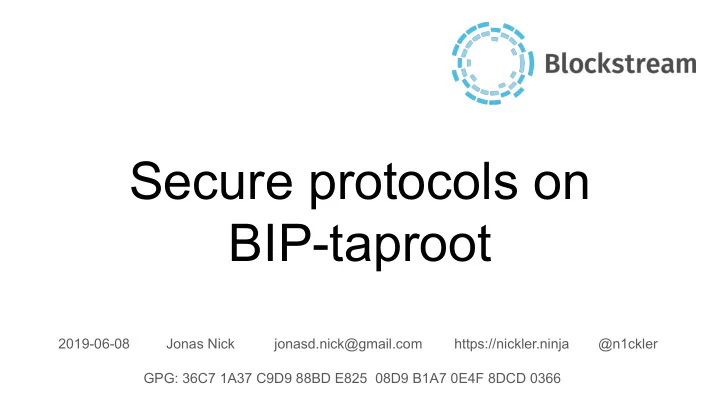

Secure protocols on BIP-taproot 2019-06-08 Jonas Nick jonasd.nick@gmail.com https://nickler.ninja @n1ckler GPG: 36C7 1A37 C9D9 88BD E825 08D9 B1A7 0E4F 8DCD 0366
Disclaimer It’s not at all certain that a BIP-taproot softfork activates in its current form or at all. This depends on community consensus.
BIP-taproot address generation (witness version 1) Policy: single key <1> <publickey> output
BIP-taproot address generation (witness version 1) Policy: single key OR script1 OR script2 OR script3 merkle root internal OR = publickey <1> <publickey> script leaf 3 output script script leaf 1 leaf 2
BIP-taproot spending output <1> <publickey> (BIP-schnorr) signature Key spend Script 2 inputs Script spend (Script 2) Script 2
bitcoin-core/secp256k1 ● “Difficult to use insecurely” ○ Well reviewed and tested ○ Fast and portable ○ Free of timing sidechannels ● rust-bitcoin/rust-secp256k1 type-safe rust bindings ( no_std ) ● Will provide cryptographic primitives for bip-taproot ○ minimum required: schnorrsig module ● elementsproject/libsecp-zkp ○ fork of secp256k1 with rangeproofs, surjectionproofs, schnorrsig, musig, … ○ just released: rust-secp256k1-zkp beta (schnorrsig, optional no_std ) ● HOWTO ○ read the docs before using it ( include/secp256k1_*.h )
secp256k1 PR #558 secp256k1-zkp module schnorrsig module rust-secp256k1-zkp module “public nonce” nonce = Number used ONCE R s 64 bytes ● Deterministic nonce derivation as per BIP-schnorr ○ Picking a specific nonce is unnecessary ● Batch verification ○ 400 sigs can be verified in half the time ○ Don’t know which exact sig was invalid ○ May not reduce worst case cost
Covert nonce channel ● Problem: malicious HWW can exfiltrate secret key through nonce
secp256k1 PR #590 Covert nonce channel protection Solution: enforce putting host-supplied randomness in nonce with sign-to-contract Alternative: MuSig key aggregation but that’s currently difficult for hardware wallets
secp256k1 Tweak Add ● Create taproot commitment if there’s a script path merkle root internal OR = publickey <1> <publickey> script leaf 3 output script script leaf 1 leaf 2
secp256k1 Tweak Add ● Create taproot commitment if there’s a script path merkle root internal OR = publickey <1> <publickey> script leaf 3 output script script leaf 1 leaf 2 P + hash(prefix, P, root)G = Q
secp256k1 Tweak Add ● Create taproot commitment if there’s a script path int secp256k1_ec_pubkey_tweak_add( const secp256k1_context* ctx, secp256k1_pubkey *pubkey, const unsigned char *tweak) P + hash(prefix, P, root)G = Q
Tweak Add Fungibility ● Try avoiding the script path ○ in multi-party contracts use “happy” case ● Don’t reuse keys ○ internal keys and leaf keys ● Using script path basically leaks wallet ○ Depth of tree, script, … ● Ensure sufficient leaf entropy merkle root internal OR publickey script leaf 3 script script leaf 1 leaf 2
Multisignature Options with BIP-taproot 1. use CHECKMULTISIG replacement opcode CHECKSIGADD ○ uses BIP-schnorr and is batch verifiable 2. Key aggregation ○ Encode n-of-n signing policy in single public key and single BIP-schnorr signature ○ more fungible, cheaper ○ interactive protocol
Key Aggregation Options 1. “Legacy”: p2wpkh key aggregation ○ complicated and 80 bits security 2. BIP-taproot: MuSig key aggregation ○ P = hash(P1, P2, 1)P1 + hash(P1, P2, 2)P2 3. BIP-taproot: Non-MuSig key aggregation ○ P = P1 + P2 , and proof of knowledge to avoid key cancellation ○ But one party can add taproot tweak! ○ P1 = P1’ + hash(prefix, P, root)G
secp256k1-zkp musig module MuSig Implementation using libsecp-zkp is safe if you 1. Never reuse a session id ○ need randomness or atomic counter 2. Never copy the state ○ otherwise: Nonce reuse and active attacks
MuSig: Reducing Communication ● Can attach the nonce (commitment) to already existing messages in protocol ○ old message: ClientHello ○ new message: (ClientHello, nonce_commitment) ● Can run multiple sessions in parallel (“pre-sharing nonces”) ● Three parallel sessions get one sig per round ○ (partial_sig_i, nonce_i+1, nonce_commitment_i+2)
MuSig with Offline/Hardware Wallets is hard ● Storing state on persistent medium is a copy ( dangerous ) ● Therefore, serializing state not supported right now in our implementation ● Just have a “single” session? ○ Need to travel to your HWW vault for every single signature ● Hope: deterministic nonce derivation ○ no randomness, no state, two rounds ○ but must be efficient ○ adds code complexity
Hash locks y such that hash(y) = Y OP_HASH <Y> OP_EQUAL
secp256k1-zkp MuSig Adaptor Signatures sig <A+B> OP_CHECKSIG adaptor_sig(Y) Bob’s reveals y, s.t. yG = Y to Alice ● DANGER : partial verification required ● Bonus: works with n-of-n, where n>=2
Blind Schnorr Signatures ● Interactive protocol between client and signing server ● Signer does not know the message being signed ● Result is a BIP-schnorr signature blind tx, some proof Alice Cosigner blind sig BIP-schnorr sig
Blind Schnorr Signatures Problems ● Vulnerable to Wagner’s attack ○ 65536 parallel signing sessions can forge a signature with only O(2^32) work ● Moreover, they can’t be proven secure in the Random Oracle Model
Blind Schnorr Signatures 1. If you just need blind signatures (f.e. ecash) ○ Don’t use blind Schnorr signatures 2. If you need blind signatures for Bitcoin transactions ○ Need to use blind Schnorr signatures ○ Idea to prevent Wagner’s attack i. Client blinds message with 128 different blinding factors and sends them to server ii. Server picks only one of those to blindly sign
Conclusion ● BIP-taproot is a substantial efficiency & fungibility improvement ● Simple sending remains simple ● Can use libsecp256k1 ecosystem for cryptography ● DL assumption is nice (fast, studied) ○ but requires interactive protocols, creates new challenges ● TODO: k-of-n threshold signatures ● Please try to break it! ● Slides at nickler.ninja/slides/2019-breaking.pdf GPG: 36C7 1A37 C9D9 88BD E825 08D9 B1A7 0E4F 8DCD 0366
Recommend
More recommend